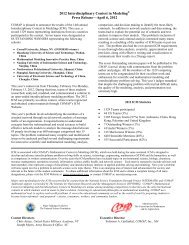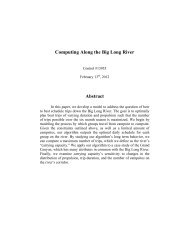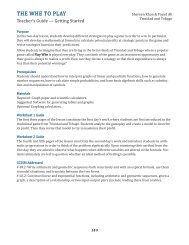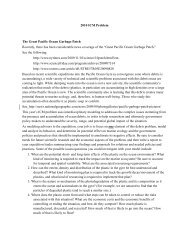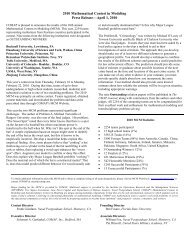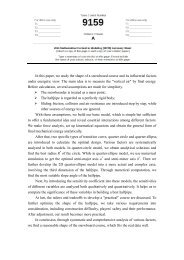Centroids, Clusters and Crime: Anchoring the Geographic Profiles of ...
Centroids, Clusters and Crime: Anchoring the Geographic Profiles of ...
Centroids, Clusters and Crime: Anchoring the Geographic Profiles of ...
Create successful ePaper yourself
Turn your PDF publications into a flip-book with our unique Google optimized e-Paper software.
Team # 7507 Page 13<br />
committed.<br />
A logical next step is to ask how much a model outperforms ano<strong>the</strong>r, which can simply<br />
be done by taking <strong>the</strong> ratio <strong>of</strong> <strong>the</strong> amount <strong>of</strong> resources allocated at <strong>the</strong> crime point under <strong>the</strong><br />
first model to <strong>the</strong> amount allocated under <strong>the</strong> second. When this ratio is greater than 1, <strong>the</strong><br />
first metric outperforms <strong>the</strong> second, <strong>and</strong> vice-versa. Assuming that <strong>the</strong> police force is twice as<br />
effective at a location when <strong>the</strong>y have twice <strong>the</strong> resources allocated, we can think <strong>of</strong> this ratio<br />
as an effectiveness multiplier, representing how many times more prepared to stop <strong>the</strong> criminal<br />
<strong>the</strong> police will be under <strong>the</strong> first model compared to <strong>the</strong> second. In this paper, effectiveness<br />
ratios will be denoted by <strong>the</strong> symbol κ:<br />
κ ≡<br />
resource allocation at crime point, model 1<br />
resource allocation at crime point, model 2<br />
Observe that if we normalize <strong>the</strong> integral <strong>of</strong> each likelihood plot to <strong>the</strong> total number <strong>of</strong><br />
resources available to <strong>the</strong> department in question, <strong>the</strong> equation above is simply a ratio <strong>of</strong> <strong>the</strong><br />
percentage <strong>of</strong> department resources allocated to <strong>the</strong> point, <strong>and</strong> since <strong>the</strong> total resources available<br />
are <strong>the</strong> same under both models, we can evaluate κ simply as<br />
κ = Z 1(<strong>Crime</strong>P oint)<br />
Z 2 (<strong>Crime</strong>P oint)<br />
where Z n is <strong>the</strong> likelihood function <strong>of</strong> model n <strong>and</strong> <strong>Crime</strong>P oint is <strong>the</strong> location <strong>of</strong> <strong>the</strong> actual<br />
next crime. We note that though this information is obviously not available in most cases, we<br />
use our metric by truncating a data sequence <strong>and</strong> using that set to predict <strong>the</strong> truncated crime.<br />
Finally, note that since a r<strong>and</strong>omly guessing algorithm, like an unconvincing psychic, will<br />
have no reason to privilege any one point over ano<strong>the</strong>r, averaging over a large number <strong>of</strong><br />
attempts to predict a crime location, <strong>the</strong>ir resource allocation appears <strong>the</strong> same as a model<br />
which produces a perfectly flat likelihood plot. This allows us to compare our model to a<br />
r<strong>and</strong>om guess by computing a “st<strong>and</strong>ard effectiveness multiplier,” in which model 2 is assumed<br />
to be a uniform, flat distribution<br />
κ s =<br />
Z 1(<strong>Crime</strong>P oint)<br />
Z flat (<strong>Crime</strong>P oint)<br />
This st<strong>and</strong>ard effectiveness multiplier κ s is <strong>the</strong> metric we will use to assess how well our<br />
model performs. A value <strong>of</strong> exactly 1 indicated it is no better (on average) than a r<strong>and</strong>om guess,<br />
<strong>and</strong> a fractional value would indicate we are actively misleading <strong>the</strong> police. The upper bound<br />
<strong>of</strong> this number is simply <strong>the</strong> magnitude <strong>of</strong> <strong>the</strong> maximum potential striking area considered by<br />
<strong>the</strong> model, which is achieved only if <strong>the</strong> model predicts <strong>the</strong> next crime point exactly <strong>and</strong> assigns<br />
it 100% likelihood 1 .<br />
1 Although much <strong>of</strong> <strong>the</strong> formalism developed around anchor point finding algorithms is applicable, this metric







